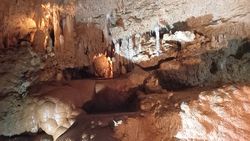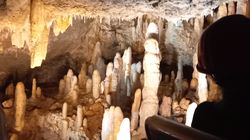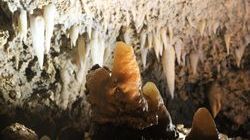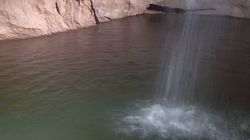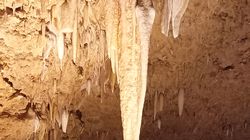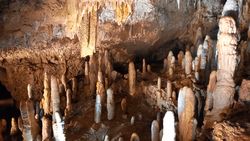Harrison's Cave
One of the Barbados Tourism Encyclopedia's "Seven Wonders of Barbados" is this spectacular cave which is one of our island's most famous attractions.
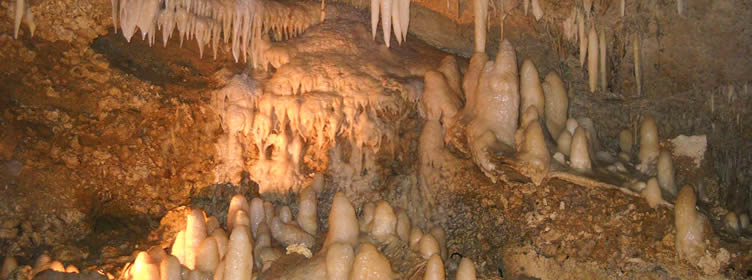
A unique phenomenon of nature, Harrison's Cave is an amazing gallery of stalactites hanging from the roof of the cave, and stalagmites that emerge from the ground, with streams of crystal-clear running water that drop from breathtaking waterfalls to form deep emerald pools. The stalactites and stalagmites were formed over thousands of years and in some places the stalactites have reached down to the stalagmites and a spectacular pillar has been formed.
The tram tour is the most popular, with visitors driven in electrically operated trams down through the extensive system of caves. Excellent tour guides give historical information on this cave along the way.
At the lowest level point in the cave, visitors are invited to leave the tram and walk alongside a spectacular waterfall which plunges into a deep pool below .... this is truly an awesome wonder! A special Early Explorers tour for the adventurous who wish to climb & crawl through the cave is also available.
And there's so much more to explore! In addition to the stunning cave, there are lots of other activities to enjoy! Zipline over the treetops, meander along the nature trail, check out the bird aviary, relax in and around the pool, take on the challenge of the high-rope obstacle course, and kick back in the Rum Lounge with the world’s oldest rum!
Tram Tour
Climb aboard the electric tram and embark on a journey to this enchanting underground world brimming with scenic streams, cascading waterfalls, and awe-inspiring stalactite and stalagmite formations. Accompanied by knowledgeable guides, delve into the hidden wonders of the cave as they reveal its captivating secrets!
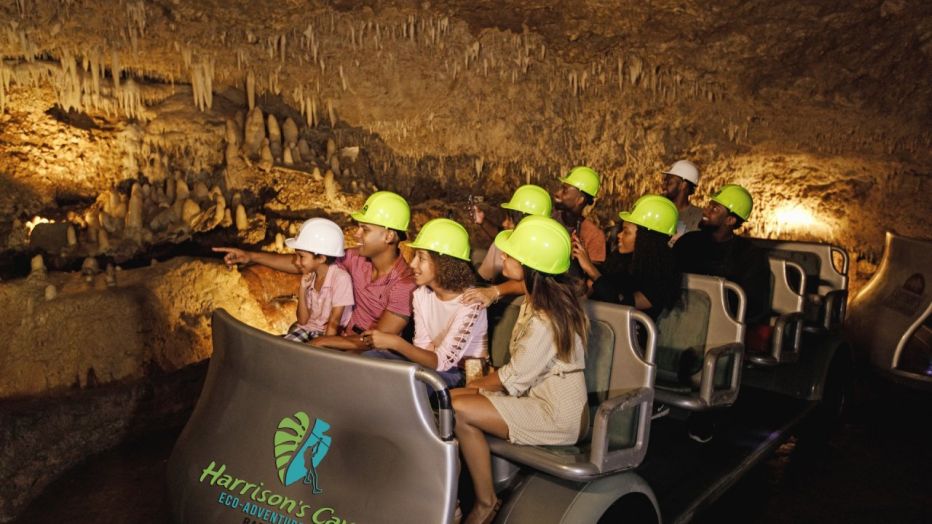
Deals & Savings
We know traveling can add up quickly, especially with so many incredible experiences calling your name across the island! That’s where Harrison's Cave makes things easier on the wallet. They offer combo adventure passes and family passes that keep the whole crew happy without breaking the bank! Web deals throughout the year also make these unforgettable experiences even more accessible.
Enjoy Even More at Harrison's Cave...
Harrison's Cave is a full-fledged Eco Adventure Park, packed with adventure, nature, and cultural activities that showcase the best of what Barbados has to offer...
Tours To Harrison's Cave
Harrison's Cave is open every day of the week. The first tour starts at 9:00 am and the last tour is at 4:00 pm.
Most local tour companies offer tours that include a stop at Harrison's Cave, one of the most popular attractions in Barbados. Touring with a guide gives you the advantage of hotel pick-up and the abilitity to combine Harrison's Cave with other top Barbados attractions.
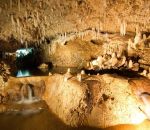 See available tours to Harrison's Cave
See available tours to Harrison's CaveSave time & money: You won't find it cheaper online or anywhere else.
Don't be disappointed: Book ahead to guarantee you don't miss out on the best tours & activities.
Getting Married In The Cave
History of Harrison's Cave
Although historical references were made to Harrison's Cave from as early as the eighteenth century, no serious exploration of the cave was done until 1970, when speleologist, Ole Sorensen, was commissioned by the Barbados National Trust to make a survey and map the cave. Sorensen immediately recognised the potential of the cave and recommended that it be landscaped and developed.
Four years later, work on the cave began, drawing on scientific, artistic, technological and geological resources. The work involved digging tunnels, improving lighting and diverting of underground streams.
Barbados Arts Council [map]
Celestine's Diner [map]
Chunky Monkey Cafe [map]
Clifton Polo Field [map]
Coco Hill Forest [map]
Cole's Cave [map]
Earthworks Pottery [map]
Flower Forest Botanical Gardens [map]
Forest Cafe [map]
Gully Challenge Obstacle Course [map]
Hamilton's Pottery [map]
Highland [map]
Hunte's Gardens [map]
Lion Castle Polo Field [map]
Monkey Feeding at Welchman Hall Gully [map]
Mount Hillaby [map]
Naniki Restaurant [map]
St. Thomas Post Office [map]
Tropical Garden Barbados [map]
Welchman Hall Gully [map]
Zipline Adventure [map]
Coral Caves and Underground Lakes of Barbados
Barbados is a fabric of soils and flora, on top of sandstone rock and coral pushed out of the sea by ancient volcanic action. The land is hilly and rocky with an underground system of rivers, caves and lakes.
The coral rocks that contain the underground water systems, are covered with a thin film of top soil measuring less than a foot on average and hardly more than a few feet at the deepest point. It is a delicate and critical balance that has supported the great sugar plantations of the past and continues to sustain a diversifying base of agricultural production.







